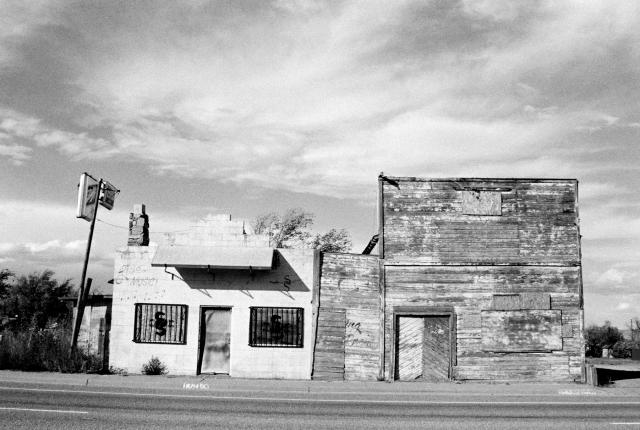Thornton-Curry Saloon. George Curry, a former Rough Rider and governor of New Mexico Territory, briefly operated a Lincoln saloon with cattleman J.Y. Thornton. Built around 1887, the adobe building that remains saw several incarnations of bars and restaurants into the 2000s. It’s one of many glimpses of the Old West that can be seen in the Lincoln Historic District.
Ira’s Bar. Serving since the 1930s, Ira Ward’s bar moved up the sidewalk on US 54 in Nara Visa to occupy its best-remembered location, the former First National Bank building. Liquor was kept in the old vault, and ranchers would gather at the bar to hear the area news. Ira’s closed in the mid-1980s.
Spurs Saloon. In the railroad village of Vaughn, two small bars stood next to each other. The one to the west was called Panebouf’s; to the east was Mary’s Bar. Sometime after 1973, they were combined to become Spurs Saloon. Shuttered since the 1980s, this Frankenstein’s monster of a building still warrants a stop—for a picture rather than a cold one.
Pioneer Tavern. The tavern opened in 1954 in Kenna, on US 70, just across the Chaves County line. Said to have been one of country musician Hank Thompson’s favorite places to play, it’s rumored that both Buddy Holly and Roy Orbison performed here, probably while recording at Norman Petty Studios, in Clovis.
Córdova’s Dancehall. Located in what is now the ghost town of Guadalupe, Juan Córdova’s dance hall once attracted people from every village in the upper Río Puerco Valley. In the 1920s, the local Tafoya brothers played while young people danced. By the 1930s, drought and economic depression put an end to the good times. When folklorist Nasario García, who grew up in the area, describes a night dancing on the dirt floor at Córdova’s, you’ll wish you’d been there.
Lito’s Ballroom. On Saturday nights in the 1940s, the people of Tierra Amarilla would gather to dance and mingle at Lito’s Ballroom. Locals say that Lito Martinez was a character who’d place speakers outside so the music could be heard throughout the village. After Martinez died in 1959, the ballroom continued as an occasional community dance space into the 1980s. Still, the charming buff-colored ballroom with its fading signage endures.


